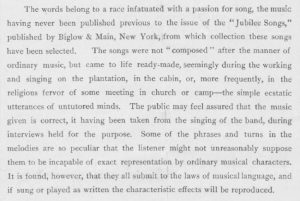It’s interesting to look at the published presentation of spirituals, which shows how the publishers were trying to market their printings. When trying to get a sense of the public perception of something during a different time in history, printed media plays a large role in perpetuating a particular view. The introduction of the Jubilee Songs and Plantation Melodies presents an interesting view of the relationship between blacks, their music, and publications.
The person the introduction is credited to is Harry Hanaford, manager. It’s unclear if he was the manager of the singers responsible for the songs, the Original Nashville Students, or of something else, and little elsewhere can be found about the name. However, it’s clear that a positive spin is being placed on things, with phrases like “The words belong to a race infatuated with a passion for song.” Of course, it is expected that an introduction to a published collection aim to promote that collection, but it is the positive framing of the origins of the song that raises an eyebrow.
It can be safely assumed that it is probably white folks reading this introduction, least of all because perhaps black folks would already know such tunes. Later in the introduction, Hanaford writes about how the Original Nashville Students have a world-wide reputation, remarking that it “must be attributed to their retaining the old Southern style, and giving a truthful representation of the negro as he appeared in the days of slavery.” Respectfully, I would either assume someone who aimed a phrase like that at a black audience to be either remarkedly condescending or severely out of touch. Rather, I would assume that such an opinion, which perhaps borders romanticization, is therefore born from a lineage that did not experience generations of slavery, and is trying to frame and sell a collection of ‘interesting songs’ to an audience that has little in the way of context.
All this to say, it’s interesting to go back and see how things were presented. A significant amount of modern understanding of past sensibilities originates from analysis of media, written opinions of said media, and statements given about current and past events. It can be difficult to gain a sense of what the common mindset was over a hundred years ago, and each little bit found contributes something to the picture. In this case, a look at a (slight) romanticized framing of something in order to sell, which no was created to appeal to a specific audience. Did that indicate the sensibilities of those people, or a general opinion of them? Was it a new attempt? I’m not sure, but it certainly puts things into perspective for how varied looking back at history can be.
The full Jubilee Songs and Plantation Melodies can be found at the University of Tennessee Music Collection:
https://digital.lib.utk.edu/collections/islandora/object/utsmc%3A17777
Hanaford, Harry. “Introduction to Jubilee Songs and Plantation Melodies.” New York, New York: Thearle, H.B., 1800-1922.
- The exact date of publication is not listed anywhere on the original piece and covers an extremely large range. This author would like to note that an alternative edition was arranged by J.J. Sawyer and published in Chicago, IL in 1884, and that the Nashville Students themselves were founded in approximately 1882; it is unlikely that this work was published before then.

